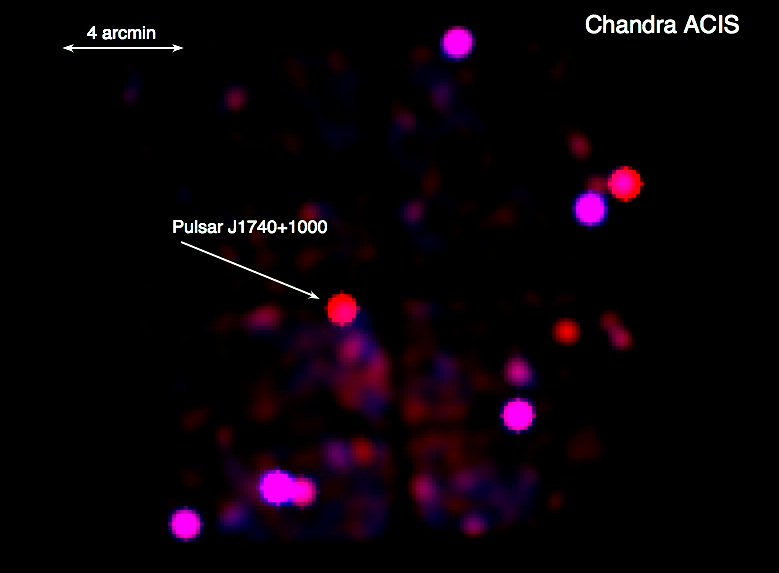Strange Emissions May Help Unlock Neutron Stars' Mysteries

Scientists have detected an odd feature in the X-ray emissions coming from a pulsar, a find that could shed light on the composition of these amazingly dense, fast-spinning stars, a new study reports.
A pulsar is a type of neutron star, the condensed remnant of an exploded star that can rotate hundreds of times per second. The pulsar in question, known as J1740+1000, was thought to be typical of its kind, which is why the discovery of absorption lines in its spectrum surprised researchers.
"So far, absorption features have been seen in five neutron stars, but very unusual ones," lead scientist Oleg Kargaltsev of George Washington University told SPACE.com.
The discovery could indicate that such features are common across neutron stars, and it may also help scientists probe the makeup of these exotic objects, researchers said. [The Strangest Things in Space]
Unusual activity
Neutron stars pack the mass of the sun into an area about the size of Washington, D.C. They form through the explosive death of another star; while the star's outer layers are blown into space, the gravitational collapse of the remaining core creates a neutron star.
Born with a spin, most neutron stars are pulsars. These objects flash a beam of electromagnetic radiation as they whirl, like the beam of a lighthouse.
Get the Space.com Newsletter
Breaking space news, the latest updates on rocket launches, skywatching events and more!
Working with three other scientists from around the world, Kargaltsev was studying the thermal emission of several neutron stars in an effort to determine their temperature. The group hoped to delve into the conditions at the surfaces of the flashing stars and understand more about what was happening inside them.
However, they saw something unusual in J1740+1000, which is found about 4,500 light-years away, in the constellation Ophiuchus (The Serpent Bearer).
"Normally the spectra of neutron stars is sort of smooth. But in our case we discovered some absorption lines," Kargaltsev said of the data obtained by the European Space Agency's XMM-Newton space telescope and NASA's Chandra X-ray Observatory.
"We did not expect them at all."
According to Kargaltsev, the unusual feature may be caused by events happening at the star's surface, or perhaps higher up in its magnetic field.
If the signal originates from atomic transitions at the surface, it could tell scientists about conditions on the outer layer of the star, including the ratio of its mass and radius. This, in turn, could reveal more information about the matter that makes up neutron stars — a puzzle that scientists are still trying to work out.
On the other hand, the absorption could arise from conditions in the star's magnetosphere. Earth's magnetic field interacts with the sun to form a region of charged particles. What might be going on around a pulsar is unknown, researchers said.
"No one thought those kinds of things might be around a neutron star," Kargaltsev said.
Above the crowd
J1740+1000 is only about 100,000 years old, relatively young for a pulsar. Before the discovery of the absorption lines, the only thing that made the flashing star stand out was its location: While most neutron stars are found within the "pancake" of the galaxy, this pulsar was high above that galactic plane.
Its location could well be the reason its unusual lines were detected. The space between stars is filled with dust and gas, and the plane of the galaxy contains more of this clutter than the regions above and below it. If the pulsar had resided within the galactic plane, the clutter would have blocked the pulsar's soft X-ray emissions from observation, Kargaltsev said.
So interference from interstellar gas could well be the reason the lines haven't been seen in other pulsars. Of the five exotic stars with absorption detected, Kargaltsev said some are closer to Earth, with less dust and gas to block them, while the signals from others are more energetic, able to penetrate the interstellar medium.
The scientists intend to focus on J1740+1000 further, hoping to learn more about what makes the spinning star tick, before moving on to three or four nearby neutron stars.
The findings were published today (Aug. 23) in the online version of the journal Science. Most of the research was done while Kargaltsev was at the University of Florida.
Follow SPACE.com for the latest in space science and exploration news on Twitter @Spacedotcomand on Facebook.
Join our Space Forums to keep talking space on the latest missions, night sky and more! And if you have a news tip, correction or comment, let us know at: community@space.com.

Nola Taylor Tillman is a contributing writer for Space.com. She loves all things space and astronomy-related, and enjoys the opportunity to learn more. She has a Bachelor’s degree in English and Astrophysics from Agnes Scott college and served as an intern at Sky & Telescope magazine. In her free time, she homeschools her four children. Follow her on Twitter at @NolaTRedd









